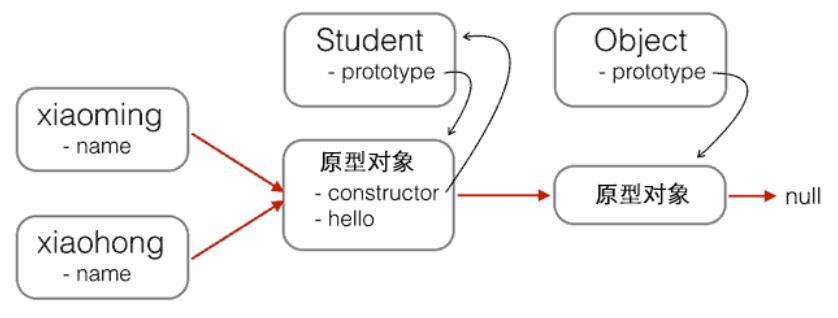您好,登录后才能下订单哦!
这篇文章主要介绍JavaScript原型继承的示例分析,文中介绍的非常详细,具有一定的参考价值,感兴趣的小伙伴们一定要看完!
在传统的基于Class的语言如Java、C++中,继承的本质是扩展一个已有的Class,并生成新的Subclass。
由于这类语言严格区分类和实例,继承实际上是类型的扩展。但是,JavaScript由于采用原型继承,我们无法直接扩展一个Class,因为根本不存在Class这种类型。
但是办法还是有的。我们先回顾Student构造函数:
function Student(props) {
this.name = props.name || 'Unnamed';
}
Student.prototype.hello = function () {
alert('Hello, ' + this.name + '!');
}以及Student的原型链:

现在,我们要基于Student扩展出PrimaryStudent,可以先定义出PrimaryStudent:
function PrimaryStudent(props) {
// 调用Student构造函数,绑定this变量:
Student.call(this, props);
this.grade = props.grade || 1;
}但是,调用了Student构造函数不等于继承了Student,PrimaryStudent创建的对象的原型是:
new PrimaryStudent() ----> PrimaryStudent.prototype ----> Object.prototype ----> null
必须想办法把原型链修改为:
new PrimaryStudent() ----> PrimaryStudent.prototype ----> Student.prototype ----> Object.prototype ----> null
这样,原型链对了,继承关系就对了。新的基于PrimaryStudent创建的对象不但能调用PrimaryStudent.prototype定义的方法,也可以调用Student.prototype定义的方法。
如果你想用最简单粗暴的方法这么干:
PrimaryStudent.prototype = Student.prototype;
是不行的!如果这样的话,PrimaryStudent和Student共享一个原型对象,那还要定义PrimaryStudent干啥?
我们必须借助一个中间对象来实现正确的原型链,这个中间对象的原型要指向Student.prototype。为了实现这一点,参考道爷(就是发明JSON的那个道格拉斯)的代码,中间对象可以用一个空函数F来实现:
// PrimaryStudent构造函数:
function PrimaryStudent(props) {
Student.call(this, props);
this.grade = props.grade || 1;
}
// 空函数F:
function F() {
}
// 把F的原型指向Student.prototype:
F.prototype = Student.prototype;
// 把PrimaryStudent的原型指向一个新的F对象,F对象的原型正好指向Student.prototype:
PrimaryStudent.prototype = new F();
// 把PrimaryStudent原型的构造函数修复为PrimaryStudent:
PrimaryStudent.prototype.constructor = PrimaryStudent;
// 继续在PrimaryStudent原型(就是new F()对象)上定义方法:
PrimaryStudent.prototype.getGrade = function () {
return this.grade;
};
// 创建xiaoming:
var xiaoming = new PrimaryStudent({
name: '小明',
grade: 2
});
xiaoming.name; // '小明'
xiaoming.grade; // 2
// 验证原型:
xiaoming.__proto__ === PrimaryStudent.prototype; // true
xiaoming.__proto__.__proto__ === Student.prototype; // true
// 验证继承关系:
xiaoming instanceof PrimaryStudent; // true
xiaoming instanceof Student; // true用一张图来表示新的原型链:

注意,函数F仅用于桥接,我们仅创建了一个new F()实例,而且,没有改变原有的Student定义的原型链。
如果把继承这个动作用一个inherits()函数封装起来,还可以隐藏F的定义,并简化代码:
function inherits(Child, Parent) {
var F = function () {};
F.prototype = Parent.prototype;
Child.prototype = new F();
Child.prototype.constructor = Child;
}
这个inherits()函数可以复用:
function Student(props) {
this.name = props.name || 'Unnamed';
}
Student.prototype.hello = function () {
alert('Hello, ' + this.name + '!');
}
function PrimaryStudent(props) {
Student.call(this, props);
this.grade = props.grade || 1;
}
// 实现原型继承链:
inherits(PrimaryStudent, Student);
// 绑定其他方法到PrimaryStudent原型:
PrimaryStudent.prototype.getGrade = function () {
return this.grade;
};JavaScript的原型继承实现方式就是:
1.定义新的构造函数,并在内部用call()调用希望“继承”的构造函数,并绑定this;
2.借助中间函数F实现原型链继承,最好通过封装的inherits函数完成;
3.继续在新的构造函数的原型上定义新方法。
以上是“JavaScript原型继承的示例分析”这篇文章的所有内容,感谢各位的阅读!希望分享的内容对大家有帮助,更多相关知识,欢迎关注亿速云行业资讯频道!
免责声明:本站发布的内容(图片、视频和文字)以原创、转载和分享为主,文章观点不代表本网站立场,如果涉及侵权请联系站长邮箱:is@yisu.com进行举报,并提供相关证据,一经查实,将立刻删除涉嫌侵权内容。